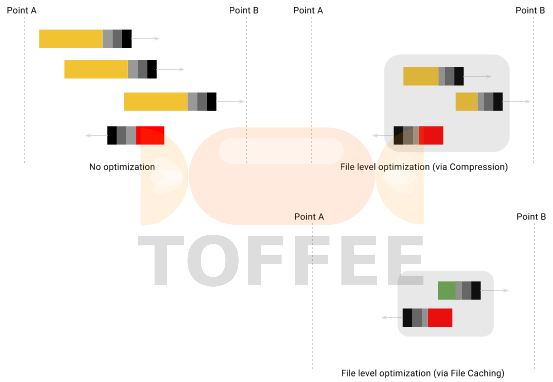RESEARCH 》 WAN Optimization iPhone and Android - Mobile App
Often I get emails from CEOs, CTOs and other tech industry experts asking me a suggestion or idea about making a iPhone and Android WAN Optimization Mobile App. They are quite curious about market potential of making such a commercial product and launching it for the users. And for all these people I get back to them with the same or similar answers and explain them the technical challenges while doing so. I see there are many drawbacks than it is really addressing any specific need. And it is one of the dumbest ideas making a mobile phone based WAN Optimization (or any network data optimization) software. Sometimes even unfortunately VPN included. Although VPN is a necessary evil to connect into the corporate network so that the employees can still be connected and work from home (or work while they are in travel or vacation). But WAN Optimization is a complete different ball game.
Security Issues and root access: It is not quite easy to make a mobile app which can get exclusive control of the whole network or data path without an exclusive root access. So if it needs to be acquired it may gain exclusive access on many more things. Making it vulnerable for any security attacks if not designed robust. This is one of the reasons it is good to do any WAN Optimization in kernel-space rather than in application space. And it is one of the reasons the entire TCP/IP and other important networking modules always exist in the kernel space.
Excessive CPU cycles: One of the other main technical challenge is that when there is network data optimization happening behind the scenes by these apps, it needs also sizable amount of free CPU cycles. This will create additional system load and when you are doing any critical work (and even say playing online games), it can choke your performance of your mobile device. No matter what is the approach you choose to use to optimize your networking data, it needs significant amount of free CPU space. Not all mobile devices can cope up this load. This will reduce your customer base since not everyone will carry a expensive high-spec smart-phone. If the users are using outdated tab and a basic spec smart phone, these Network optimization apps can never be used effectively in these devices. So there is no justification ever customers will be paying for these apps and figure out suddenly your app is not compilable for their mobile phone CPUs.
Or there can be a case they may like initially during some free trial period. But when they pay money and subscribe for paid service, they may experience CPU overload and sluggish performance during their course of usage. This can in turn result in over-heating and excessive battery consumption.
Backdoors and security issues: Customers using any mobile based WAN Optimization or Network optimization apps are always at high risk. If this application gets hacked it can act as a medium to hack almost the entire mobile device and all its other apps. And sometimes these apps may have some backdoors for some engineering reasons and hackers can spot these backdoors and can gain access and control. And if these WAN Optimization apps are doing decryption of encrypted SSL traffic, any attack on this app will lead to nasty consequences.
Government regulations: Government will always try to regulate on any networking solution which creates any optimized and or encrypted tunnels. Often times these are not according to any industry standards which is the reason in the first place they need to comply government regulations specific to that country. And if you are an Network optimization app company (for example from US), and if you want to release this commercial app to other countries, you need to follow their local government guidelines, modify the app according to those guidelines and need to release the same. And get proper license to operate if required. Or may need to open backdoors for them so that if needed they can gain access to this optimized network you are trying to create.
The bottom-line truth - Unfortunately there are no proper industry standards exists on WAN Optimization technology. There are only commercial patents exist which are often not much disclosed and discussed in public.
So this is the reason I never recommend making any iPhone and Android based WAN Optimization (or Network Optimization) commercial mobile app. I consider it is a dumbest idea. It can work well in some few specific use-cases but not suitable in general common usage scenarios.
Here is my detailed Youtube video of the same:
Suggested Topics:
WAN Optimization and Network Optimization
| 💎 TOFFEE-MOCHA new bootable ISO: | Download |
| 💎 TOFFEE Data-Center Big picture and Overview: | Download PDF |

Saturday' 13-Mar-2021

Saturday' 13-Mar-2021

Saturday' 13-Mar-2021

Saturday' 13-Mar-2021

Saturday' 13-Mar-2021
Featured Educational Video:

Saturday' 13-Mar-2021

Saturday' 13-Mar-2021
Research :: Optimization of network data (WAN Optimization) at various levels:

Learn Linux Systems Software and Kernel Programming:

Hardware Compression and Decompression Accelerator Cards:

TOFFEE-DataCenter on a Dell Server - Intel Xeon E5645 CPU:



